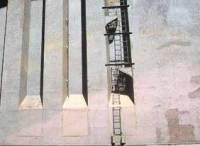
Steamship Mutual
Published: April 01, 2008

As is usual in the case of a fatality onboard a vessel, the death of an experienced 47 year old Able Seaman onboard a geared handy sized bulk carrier was the result of a number of contributory factors which, when taken together, proved to be fatal.
The vessel was on a ballast voyage from Tuticorin, India to Dampier, Australia to load a cargo of salt. Prior to arrival at the load port, whilst on passage, the crew were engaged in cleaning the holds in preperation for loading the salt cargo. The first stage of the hold cleaning process involved spraying the hold surfaces with a 31% hydrochloric acid in water solution, using a small air driven pump, to help remove rust. This is subsequently left for a period of time prior to being washed off using sea water. The holds are then sprayed with a diluted alkaline solution to neutralise any remaining acid, this is then left for a period of time before being washed off using fresh water. The final stage of the hold preperation involves lime washing the holds prior to loading.
On this particular day the two crew members were engaged in spraying no.3 hold with the hydrochloric acid solution. Hydrocholric acid solution or spray mist can have a corrosive effect on human tissue and may lead to damage to eyes, respiritory organs or intestines. Chronic overexposure may also lead to dizzyness, headaches or repiratory difficulties.
Due to the number of health issues associated with using hydrochloric acid the crew were wearing the requisite personal protective equipment consisting of rubber gloves, wet weather jackets and trousers over their boilersuits, wellington boots, hards hats and full face respirators.
The aft bulkhead had been sprayed and spraying had progressed to the mid point of the port side of the hull when work was completed for the day. The two men then proceed to depart from the hold, one using the forward access ladder, the other the aft access ladder. Both ladders were of the ‘Australian’ type with intermediate platforms between the tank top and the deck, although the aft ladder had an inclined staircase at its mid section making it easier to climb. As the seaman on the aft ladder reached the top and was about to exit the hold he heard a loud thump and turned around to see his colleague lying on the tank top near the base of the ladder. The seaman left the hold and reported what he had seen to the bridge via his handheld radio. The Chief Officer made a public address announcement, was subsequently relieved from the bridge by the master and proceeded to the deck where he organised the crew such that an entry could be made to enter the hold. Fearing that the crewman had collapsed due to a suspect atmosphere within the hold the chief officer donned a self-contained breathing apparatus and proceeded to the base of the hold to check on him. Another crewman donned an emergency escape breathing device (EEBD) and followed the Chief Officer into the hold.
The seaman was found to have suffered a severe head injury and no pulse was present. With the input of a doctor connected via the Rescue Co-ordination Centre it was confirmed that the seaman was deceased. A subsequent post-mortem examination revealed that the seaman had died as a result of the severe head injury.
Nobody saw the seaman fall and the ladder was found to be in good condition. It can only be surmised, therefore, that the fatality was due to one or more of the following possible causes:
Fatigue: The seaman was engaged as lookout on the 0000-0400 and 1200-1600 watch and then 2 additional hours overtime., As is normal practice on many ships, he was engaged in deckwork during his daylight watchkeeping hours and had been engaged in hold cleaning from 1000 until his death at 1630. His working hours were within the requirements of STCW 95 and with adequate rest between watches the seaman should not have been unduly fatigued. However, he was engaged in a physical activity in the tropics with an outside temperature of around 29°C while wearing wet weather clothing. In addition, the ladder at the forward end of the hold consisted of 4 vertical ladders with platforms between each and it is possible that at the end of a long day working under ardous conditions he was tired and his attention was not fully focussed on climbing the ladder out of the hold.
Personal Protective Equipment: The seaman engaged in the hydrochloric acid spraying were wearing wet weather jackets and trousers over their boiler suits, wellington boots, rubber gloves, hard hats and a full face respirator. Whilst climbing the ladders it is possible that the gloves, being rubber on sweat covered hands did not afford the most secure grip on the ladder. Wellington boots are often looser than normal safety boots or shoes, making them more difficult to climb with. It is also possible that if the soles were wet following the cleaning operation, they may have afforded him less grip on the ladder rungs.The seaman’s respirator was found on the first platform from the tanktop; the securing straps had been deliberately released, so it appears that the seaman removed the mask either prior to climbing the ladder or whilst on one of the intermediate platforms. The fact that he was therefore carrying it whilst climbing would have hindered his climbing ability. The seaman’s hard hat was found undamaged on the tanktop away from his body and, although fitted with a chin strap, it appears that he did not refit it having removed the hat so as to take off the respirator. In addition, hydrochloric acid solution was found on the seaman’s face in the area that would have been covered by the mask when he was working. It is, therefore, possible that the solution had mixed with his perspiration and either iritated his skin or stung his eyes thereby impeding his progress or impairing his vision as he climbed the ladder.
Hydrocholoric Acid: The seaman had been engaged in the task of cleaning the hold for several hours and the effectiviness of the respirator protecting him as he worked is unknown; it is therefore possible that he was suffering some of the effects which are attributed to over- exposure to hydrocholoric acid, such as dizzyness or headaches..
Safety Management Procedures: The ship’s Safety Management System required that a risk assesment be conducted prior to any hazardous operations. As the officers and crew on this vessel had conducted this task previously only a talk was held at the beginning of the day. No formal risk assessment was conducted prior to the operation nor any written instructions issued. If this had been done the risks associated with the product would have been fully assessed and the task of climbing the ladder would have been noted, hazards associated with the task identified and suitable mitgating measures put in place.
Material Safety Data Sheets (MSDS): Although the labels on the drums of cleaning liquid had alerted the crew to the corrosive nature of the product, they were not aware of all of the hazards that the hydrochloric acid could pose. The master was able to provide a copy of the MSDS for the product, however, the Chief Officer and crew were not aware that the document existed and, in fact, were not even aware of what an MSDS was. Therefore, even if a formal risk assessment had taken place, its value would have been limited as not all the dangers associated with the cleaning product would have been known.
Rescuers or Further Victims? One final item which deserves mention in this case is the hold entry which was instigated following the raising of the alarm; enclosed space rescue drills are a 3 monthly requirement on many vessels. It is not known if these had been undertaken on this vessel. If such a rescue is needed the procedures in the Safety Management System are followed to ensure that rescuers do not become further victims. In this instance, although the Chief Officer donned a self-contained breathing apparatus, the seaman who followed him down the ladder used only an emergency escape breathing device (EEBD); this was an entirely inappropriate piece of equipment to use in the circumstances as it is only suitable for use for very limited periods of time; in other circumstances, that decision alone could have proved fatal.


